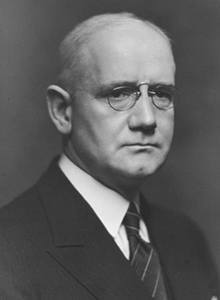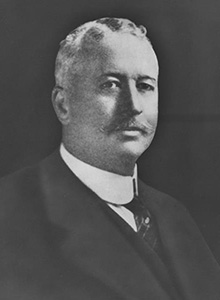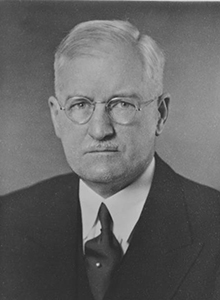
William A. Day
- President, Federal Reserve Bank of San Francisco, 1936–1945
- Born: March 15, 1876
- Died: May 26, 1951
William A. Day served as president of the Federal Reserve Bank of San Francisco from April 1, 1936, until his retirement on December 31, 1945. The 1935 Banking Act required that the title for chief executive officers of Reserve Banks be changed from governor to president. Likewise, deputy governor became vice president and assistant deputy governor changed to assistant vice president.
Day was born in San Francisco in 1876 and attended city schools. He began his banking career in 1897 as a messenger for the Bank of California, N.A. He worked at Mission Bank in 1906 and Mechanics Savings in 1907. From 1908 to 1917 he was with the Savings Union Bank and Trust Company, where he helped establish a commercial department. “His success as head of this department,” said the San Francisco Chronicle on April 7, 1922, got the attention of San Francisco Fed executives, who brought him onboard in July 1917.
Day was assistant deputy governor at the San Francisco Fed until 1918. He also served as acting manager of the Portland Branch when it opened in 1917 and held the same position when Salt Lake City Branch opened in 1918.
When the United States entered World War II, the Federal Reserve System was not immune from war-related responsibilities. Reserve Banks helped the Treasury Department raise funds through sales of war bonds.
As chairman of the War Finance Committee for the Twelfth Federal Reserve District, Day was tasked with encouraging organizations and individuals in Western states to purchase special securities in support of the war effort. From December 1942 to December 1945 and over the course of seven War Loan Drives and one Victory Loan Drive, the Twelfth District raised more than $11 billion.
After the attack on Pearl Harbor and US entry into the war, President Franklin D. Roosevelt issued Executive Order 9066, which authorized the secretary of War and military commanders to designate areas from which people could be prohibited in order to protect “against espionage and against sabotage to national-defense material, national-defense premises, and national-defense utilities.”
Lt. Gen. John L. DeWitt, commanding general of the Western Defense Command and Fourth Army, ordered the evacuation of people of Japanese descent from the West Coast, and the Treasury Department gave the San Francisco Fed responsibility for helping evacuees store or liquidate their property and mediating disputes with evacuees’ creditors. A bank press release dated March 10, 1942, said, “The objective of the program will be to bring about a fair and just liquidation of that property which the evacuees cannot take with them.”
The bank’s newly created Evacuee Property Program was supervised by Vice President William H. Hale and Assistant Cashier R.E. Everson, but President Day sent a letter on March 14 to member banks of the Twelfth District requesting their participation and support.
Day was active in the American Institute of Banking. He was a charter member when the San Francisco Chapter started in 1902. He was a delegate to the first AIB convention in Cleveland in 1903 and served as president of the San Francisco Chapter for the term 1910-12, along with holding many other offices during the years he devoted to the welfare and development of the institute.
Day died in 1951 at age seventy-five.
Written by the Federal Reserve Bank of San Francisco. See disclaimer.




